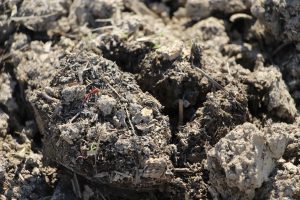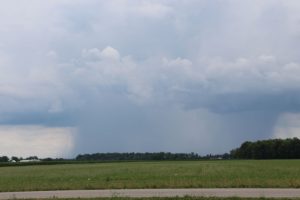Grain Marketing, Homepage Slider, Water Quality
The Smell of Rain and Microbes
By James Hoorman, Hoorman Soil Health Services
After a dry summer, the smell of rain is often refreshing but maybe a little less so to farmers at harvest time! People can often sense it is going to rain. This “pre-rain” smell comes from ozone formed when oxygen (O2) in the atmosphere is spilt through electrical charges in the clouds to form ozone (O3). Ozone is blown down from the upper atmosphere and has a sharp odor, somewhat like chlorine or burnt wires. This pre-rain smell is a good indication a storm is brewing before the pleasant smell of rain occurs.
Recent research shows that the smell of rain is caused by soil actinomycetes or actinbacteria. Scientist have a name for it called petrichlor (pronounced pet-try-cure). As rain infiltrates the soil, it causes the actinomycetes to form spores which are released along with geosmin, a chemical that creates that earthy soil smell when soil is tilled. Geosmin and petrichlor are especially more intense in healthy soils, due to higher soil microbial activity. If a soil is unhealthy with fewer microbes; the soil may smell stale, lack oxygen, be rank and smell like sulfur causing a less intense rain smell at that location. Healthy soils have more oxygen and have a sweeter aroma due to healthy microbes.
less intense rain smell at that location. Healthy soils have more oxygen and have a sweeter aroma due to healthy microbes.
Geosmin boosts certain chemicals like serotonin and norepinephrine in your brain which act like antidepressants. Rain on healthy soils may decrease stress and improve your mood by 60%. The human nose can detect geosmin at 5 part per trillion or very low levels. That’s why a good rain can be so refreshing to human mental health and is related to healthy soil microbes.
Soil and plant microbes also have a big impact on making it rain, hail, and snow in the first place. During photosynthesis, plants transpire water and microbes into the atmosphere. The living microbes form a protein that attracts water molecules and dust particles which allow water vapor to turn into ice crystals so that it can fall down to earth. Pure water does not freeze until (-400F), but impurities in water allows ice to form at higher temperatures. According to NOAA, “new research shows that a large variety of bacteria, and even fungi, diatoms and algae, persist in the clouds and are used as precipitation starters, a growing field of study called bioprecipitation. In order for snow to fall from clouds, particles around which ice crystals can form — called ice nuclei — are needed.”
A soil microbe bacterium called Pseudomonias predominants in allowing snow and ice crystals to form throughout the world. In the tropics; photosynthesis, transpiration, and the release of these microbes into the atmosphere generates rains every day for a short period of time around 4PM. Without good soil health and beneficial microbes, the water cycle would be changed dramatically, resulting in fewer more intense large rainfall events rather than regular smaller rainfall events.